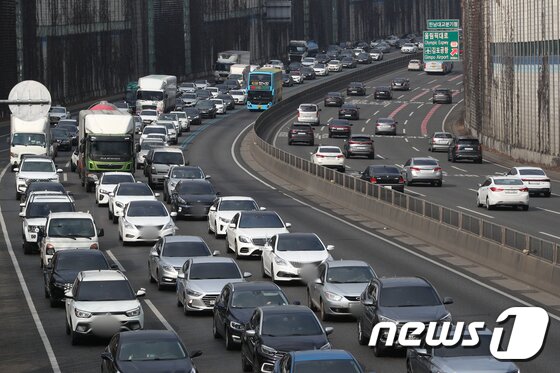 |
| On the afternoon of the 10th, one day before the Lunar New Year holiday, the direction of Busan near Jamwon IC on the Gyeongbu Expressway in Seocho-gu, Seoul is showing congestion. . 2021.2.10/News 1 © News1 |
On the 12th of Lunar New Year, traffic congestion continues in major road sections, with the number of vehicles used on highways nationwide is expected to reach 4.3 million.
According to the Korea Expressway Corporation, cars are walking tortoises in the 3km section between Dalraenae and Banpo on the Gyeongbu line toward Seoul.
In addition, traffic flow is stagnating in the vicinity of Suwon-2km of Suwon, 5km of Cheongju-near Oksan, 4km of Hoedeok Junction-4km of Sintanjin, and 3km of Yangsan-near Seokgye.
In the direction of Busan on the Gyeongbu Line, cars are not speeding in the 4km section from Hannam to Seocho, the 6km section from Jukjeon to the Suwon, the 7km section from Osan to Namsa, and the 2km section from the Daejeon Tunnel to Biryong Junction.
In the direction of Mokpo on the West Coast Line, traffic congestion occurs in the vicinity of Sunsan Tunnel, 2 km from Bibong to Bibong, and 6 km from Seopyeongtaek to Seohae Bridge.
Based on the departure of the toll booth at 3pm, the estimated time from major cities to Seoul is △5 hours and 10 minutes in Busan △4 hours and 40 minutes in Ulsan △3 hours and 30 minutes in Gangneung △2 hours and 30 minutes in Yangyang (arrival in Namyangju) △2 hours 20 in Daejeon Minutes △ Gwangju 4 hours △ Mokpo 3 hours 50 minutes △ Daegu 4 hours 10 minutes.
At the same time, the estimated time required by car from Seoul to each major city is: △Busan 4 hours and 40 minutes △ Ulsan 4 hours and 40 minutes △ Gangneung 2 hours and 50 minutes △ Yangyang 2 hours and 10 minutes (from Namyangju) △ Daejeon 2 hours △ Gwangju 3 Time 30 minutes △ Mokpo 3 hours 50 minutes △ Daegu 3 hours 40 minutes.
On this day, the number of vehicles using the highway is expected to be 4.29 million, which is 510,000 more than the 3.78 million (estimated) vehicles used the previous day.
It is predicted that 390,000 vehicles heading from the metropolitan area to the provinces, and 380,000 cars coming up from the provinces to the metropolitan area.
The congestion on the way home is expected to start at 7-8 a.m. and peak at 1-2 p.m., and then resolve at 7-8 p.m.
The congestion on the Gwigyeong-gil is expected to start at 9-10 a.m. and reach a peak at 1-2 p.m., and then be resolved at 10-11 p.m.
Two-way congestion continues from morning to late night, and it is analyzed that traffic congestion will be the most severe on this day of the holiday (11-14).
